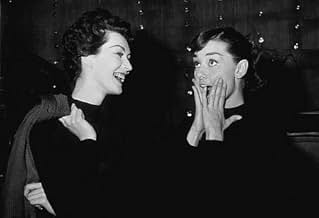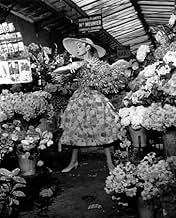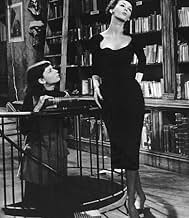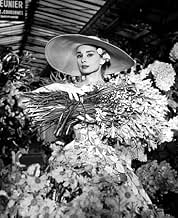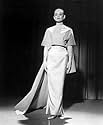AVALIAÇÃO DA IMDb
7,0/10
35 mil
SUA AVALIAÇÃO
Um ensaio improvisado de moda em uma livraria traz a descoberta de uma nova modelo no balcão da loja.Um ensaio improvisado de moda em uma livraria traz a descoberta de uma nova modelo no balcão da loja.Um ensaio improvisado de moda em uma livraria traz a descoberta de uma nova modelo no balcão da loja.
- Indicado a 4 Oscars
- 2 vitórias e 10 indicações no total
Heather Ames
- Junior Editor
- (não creditado)
Fern Barry
- Southern Wife
- (não creditado)
Brandon Beach
- Fashion Show Guest
- (não creditado)
Paul Bisciglia
- Photographer
- (não creditado)
Avaliações em destaque
This 1957 musical is a little odd. It has a title based on an original 1920s Gershwin musical (that included the title song) which starred Fred and Adele Astaire. It was a musical and scenic valentine to France (but only one tune in it deals with France - "Bonjour Paris!". It is a spoof on the modern fashion magazines, fashions in general, and advertising - but the spoof while sharp at times is never pushed. The opening sequence, "Think Pink," describes how Kay Thompson plans a campaign to make the American woman go for "pink" clothes, accessories, toothpaste, etc., only to admit to her assistant she personally loathes the color. It takes full advantage of the attractive face and features of Hepburn, who is convinced to be a model and help push a new line of fashions in Paris. And it makes two characters into imitations of Richard Avedon the photographer (Astaire as Dick Avory) and Jean-Paul Sartre (Michel Auclair as Prof. Emile Flostre).
Avedon was a rarity - a fashion photographer who became a great artistic portrait photographer. Astaire never is shown taking pictures of great or famous people in the film but several times he demonstrates a refinement that separates him from the rest of Kay Thompson's entourage (most of whom don't care what havoc they cause, as long as they get their jobs done). He also has enough sense to question Hepburn's accepting of "empathicalism", and it's viability. Witness his moment in the bistro pouring wine to the two old codgers who are quite pleasant to him while he insults them in English. Hepburn, of course, is so insistent on the validity of her philosophical beliefs that she rejects Astaire's warnings, and jeopardizes the fashion show.
The final blow (seemingly) to the Astaire - Hepburn relationship is when he confronts Flostre at the author's home. He knocks out the Professor, and his brutality demolishes the relationship with Hepburn. But within minutes Hepburn sees another side to Flostre which is unexpected, and suddenly realizes that Astaire may be right after all.
The character of Flostre is obviously based on that of Jean-Paul Sartre, the founder of "existentialism". Based on in some details, but not in theory. "Empathicalism" has to do with trying to empathize with others so as to have a proper response to their needs and aspirations. "Existentialism" has to do with: "An introspective humanism or theory of man which expresses the individual's intense awareness of his contingency and freedom; a theory which states that the existence of the individual precedes his essence." This is from Webster's New Collegiate Dictionary. Sartre has a more complex view of man and society, and one can plow through BEING AND NOTHINGNESS to try to understand it. In fact some critics have wondered if the Nobel Prize Winner eventually got very wrong headed about his theory. But he certainly seems a meatier philosopher than his celluloid copy.
But Flostre does have the trappings of Sartre on him. He is revered by his followers world wide (such as Hepburn). He is a man with sexual appetite (as Sartre was with his long time companion and fellow writer Simone Beauvoir). And there is some traces of an anti-capitalist, even anti-American attitude in him. It is not definitely pushed, but when Astaire and Thompson break into his house during a party, they pretend they are American share cropper singers whom Flostre had brought to France to perform for his guests. Now, we never hear what this actual pair actually would sing, but judging from their background they would have to throw in some protest songs. Sartre was very critical of the U.S.A. and capitalism (today his fans have to explain Sartre's willingness to accept Russian imperialist moves under Communism in the 1940s, 1950s, and 1960s - they find it very hard to do so).
On the whole the parts of the film work well, so I give it seven stars. Kay Thompson is best recalled for being the creator of the little girl at the Plaza "Eloise", but she shows here a highly entertaining performance as Maggie Prescott, the editor who pushes and loathes pink. The film would have been better if somehow Avedon's portrait photography had been brought into the story, possibly in a final scene with Flostre as his subject. However, even without such a sequence the film is rewarding to watch, especially in the musical numbers. Astaire does equally well with Thompson and with Hepburn as his partners here.
Avedon was a rarity - a fashion photographer who became a great artistic portrait photographer. Astaire never is shown taking pictures of great or famous people in the film but several times he demonstrates a refinement that separates him from the rest of Kay Thompson's entourage (most of whom don't care what havoc they cause, as long as they get their jobs done). He also has enough sense to question Hepburn's accepting of "empathicalism", and it's viability. Witness his moment in the bistro pouring wine to the two old codgers who are quite pleasant to him while he insults them in English. Hepburn, of course, is so insistent on the validity of her philosophical beliefs that she rejects Astaire's warnings, and jeopardizes the fashion show.
The final blow (seemingly) to the Astaire - Hepburn relationship is when he confronts Flostre at the author's home. He knocks out the Professor, and his brutality demolishes the relationship with Hepburn. But within minutes Hepburn sees another side to Flostre which is unexpected, and suddenly realizes that Astaire may be right after all.
The character of Flostre is obviously based on that of Jean-Paul Sartre, the founder of "existentialism". Based on in some details, but not in theory. "Empathicalism" has to do with trying to empathize with others so as to have a proper response to their needs and aspirations. "Existentialism" has to do with: "An introspective humanism or theory of man which expresses the individual's intense awareness of his contingency and freedom; a theory which states that the existence of the individual precedes his essence." This is from Webster's New Collegiate Dictionary. Sartre has a more complex view of man and society, and one can plow through BEING AND NOTHINGNESS to try to understand it. In fact some critics have wondered if the Nobel Prize Winner eventually got very wrong headed about his theory. But he certainly seems a meatier philosopher than his celluloid copy.
But Flostre does have the trappings of Sartre on him. He is revered by his followers world wide (such as Hepburn). He is a man with sexual appetite (as Sartre was with his long time companion and fellow writer Simone Beauvoir). And there is some traces of an anti-capitalist, even anti-American attitude in him. It is not definitely pushed, but when Astaire and Thompson break into his house during a party, they pretend they are American share cropper singers whom Flostre had brought to France to perform for his guests. Now, we never hear what this actual pair actually would sing, but judging from their background they would have to throw in some protest songs. Sartre was very critical of the U.S.A. and capitalism (today his fans have to explain Sartre's willingness to accept Russian imperialist moves under Communism in the 1940s, 1950s, and 1960s - they find it very hard to do so).
On the whole the parts of the film work well, so I give it seven stars. Kay Thompson is best recalled for being the creator of the little girl at the Plaza "Eloise", but she shows here a highly entertaining performance as Maggie Prescott, the editor who pushes and loathes pink. The film would have been better if somehow Avedon's portrait photography had been brought into the story, possibly in a final scene with Flostre as his subject. However, even without such a sequence the film is rewarding to watch, especially in the musical numbers. Astaire does equally well with Thompson and with Hepburn as his partners here.
"Funny Face" was great fun during its first runs and is still a most enjoyable musical. A top notch cast headed by Audrey Hepburn and Fred Astaire make this a winner. Kaye Thompson is on hand for songs, dances and laughs, and George Gershwin's score sparkles. Filmed in part on location in Paris, "Funny Face" beautifully conveys its story of romance with elegance and charm. Smart fashion costumes, photography and choreography combine to make this a hit.
Outstanding. Beautiful. Classic. What a real lady!!!
The photo sequence in Paris has never been topped. Such a 10+ movie, I can just watch it over and over. Those are kind of strange adjectives and comments from me, especially since I'm a Sci-Fi, action, fantasy kind of movie fan.
This makes me wonder, will we ever have another Audrey?? Maybe an actress who is even close? To think that she thought she had: 1. A square face, 2. A big nose and 3. Big feet. That just shows how human and natural she really was..........
What a surprise for me to find this movie. I had never even heard of it untill it came out on DVD. S'Marvelous!!
The photo sequence in Paris has never been topped. Such a 10+ movie, I can just watch it over and over. Those are kind of strange adjectives and comments from me, especially since I'm a Sci-Fi, action, fantasy kind of movie fan.
This makes me wonder, will we ever have another Audrey?? Maybe an actress who is even close? To think that she thought she had: 1. A square face, 2. A big nose and 3. Big feet. That just shows how human and natural she really was..........
What a surprise for me to find this movie. I had never even heard of it untill it came out on DVD. S'Marvelous!!
The first of two films released in 1957 in which Fred Astaire effectively bade farewell to the genre he had bestrode like a colossus for nearly a quarter of a century is the cinematic equivalent of gorging yourself on a box of chocolates without the calories.
The title photographs by Richard Avedon (on whom the character played by Astaire was based) establish the iconic fifties cool that never lets up for the rest of the film. Had they shot the whole thing in the studio, the Gershwin score, Technicolor, VistaVision and Edith Head creations worn by all the cast but Audrey Hepburn would already have induced pleasure overload. But producer Roger Edens also shipped the crew to Paris and whipped that into the brew.
It shows how spoiled they were in those days that it didn't collect a single Oscar.
The title photographs by Richard Avedon (on whom the character played by Astaire was based) establish the iconic fifties cool that never lets up for the rest of the film. Had they shot the whole thing in the studio, the Gershwin score, Technicolor, VistaVision and Edith Head creations worn by all the cast but Audrey Hepburn would already have induced pleasure overload. But producer Roger Edens also shipped the crew to Paris and whipped that into the brew.
It shows how spoiled they were in those days that it didn't collect a single Oscar.
This snappy musical teams an ageing Fred Astaire with the young and lively Audrey Hepburn, puts them in Paris with a lovely Gershwin score, and piles on the slush to create romantic confection that really is irresistible.
Audrey is at her best here, whether singing (in her own voice) How Long Has This Been Going On?', dancing wildly around a café, or looking like a mannequin in the fabulous frocks. Kay Thompson is on hand too, with her own fabulous number, Think Pink' about the trials and tribulations of being a fashion magazine editor.
It probably works best with the misty filters and the dreamy sequences, though. And Audrey is serenaded by Fred dancing beneath her window, like the dashing prince who comes to rescue Rapunzel. Musical corn perhaps, but addictive nonetheless.
Audrey is at her best here, whether singing (in her own voice) How Long Has This Been Going On?', dancing wildly around a café, or looking like a mannequin in the fabulous frocks. Kay Thompson is on hand too, with her own fabulous number, Think Pink' about the trials and tribulations of being a fashion magazine editor.
It probably works best with the misty filters and the dreamy sequences, though. And Audrey is serenaded by Fred dancing beneath her window, like the dashing prince who comes to rescue Rapunzel. Musical corn perhaps, but addictive nonetheless.
Você sabia?
- CuriosidadesFred Astaire's character is based on photographer Richard Avedon and his wife, Doe, who, like the character "Jo Stockton," became a noted model despite her indifference toward that profession. In fact, it is Avedon who set up most of the photography for this film, including the famous face portrait of Audrey Hepburn unveiled during the darkroom sequence.
- Erros de gravaçãoAfter Dick kisses Jo and leaves the bookstore, Jo begins to sing "How Long Has This Been Going On". As she sings to herself while looking at the mirror in the supposedly empty bookstore, someone is reflected in the mirror moving around on the second floor of the bookstore.
- Citações
Dick Avery: When I get through with you, you'll look like... What do you call beautiful? A tree. You'll look like a tree.
- Cenas durante ou pós-créditosThe opening credits, designed by film consultant Richard Avedon, consist of traditional film credit display interspersed with live action, fashion models and photographic film.
- Trilhas sonorasOverture: Funny Face/'S Wonderful/Think Pink!
(uncredited)
Lyrics by Ira Gershwin
Music by George Gershwin
Performed by Fred Astaire
Principais escolhas
Faça login para avaliar e ver a lista de recomendações personalizadas
Detalhes
- Data de lançamento
- País de origem
- Idiomas
- Também conhecido como
- La cenicienta de París
- Locações de filme
- Château de la reine blanche, Coye-la-Forêt, Oise, França(wedding dress photo shoot, Dick's marriage proposal)
- Empresa de produção
- Consulte mais créditos da empresa na IMDbPro
Bilheteria
- Orçamento
- US$ 3.000.000 (estimativa)
- Faturamento bruto mundial
- US$ 1.669
- Tempo de duração
- 1 h 43 min(103 min)
- Cor
- Proporção
- 1.85 : 1
Contribua para esta página
Sugerir uma alteração ou adicionar conteúdo ausente







